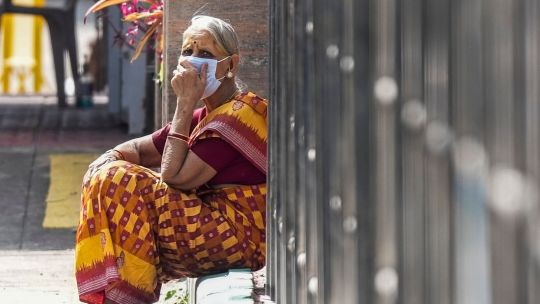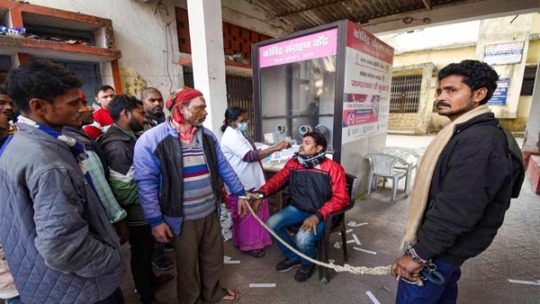#covid-19 cases in india
Text
Latest COVID-19 Developments: India's JN-1 Variant Insights
Explore insights into COVID-19, rising cases in India, and the JN-1 variant. Stay informed on preventive measures and vaccination for a healthier future.
8 notes
·
View notes
Text
Latest COVID-19 Developments: India's JN-1 Variant Insights
Explore insights into COVID-19, rising cases in India, and the JN-1 variant. Stay informed on preventive measures and vaccination for a healthier future.
0 notes
Text
India Reports 602 New Covid 19 Cases: बढ़ता जा रहा कोरोना का खतरा, बीते 24 घंटे में मिले 602 नए संक्रमित, 5 की मौत
India Reports 602 New Covid 19 Cases: भारत में कोरोना तेजी से फैल रहा है. पिछले 24 घंटों के दौरान देश में कुल 602 नए कोरोना वायरस मामले सामने आए हैं। इस दौरान 5 मरीजों की मौत भी हुई है. 602 नए संक्रमितों की पहचान के साथ गतिशील कैसलोएड 4,440 तक पहुंच गया है।
India Reports 602 New Covid 19 Cases
स्वास्थ्य और परिवार सरकारी सहायता शाखा ने मंगलवार को कहा कि कर्नाटक सरकार ने पिछले 24 घंटों में…

View On WordPress
0 notes
Text
Covid JN.1 LIVE: 63 cases of new variant reported in 24 hours, Karnataka Cabinet sub-committee meeting today
COVID-19 JN.1 Variant News Live Updates: Amid growing concerns over rising cases of COVID-19 sub-variant JN.1, a total of 63 cases of the sub-variant have been detected in India as of Sunday.
Citing Health Ministry sources, ANI on Monday reported that Goa is the biggest contributor to the cases, where 34 cases were reported in a single day.
Apart from Goa, nine are from Maharashtra, eight from…

View On WordPress
#Cabinet#cases#Corona virus cases in my state#COVID#covid 19 cases in india#Covid 19 JN.1 variant#covid 19 latest updates#covid 19 live updates#Covid JN.1 LIVE: 63 cases of new variant reported in 24 hours#COVID JN.1 variant#covid kerala#covid kerala news#covid live updates.covid restrictions#covid maharashtra news#covid new variant#Hours#JN.1#Karnataka#Karnataka Cabinet sub-committee meeting today#Live#Meeting#reported#subcommittee#Today#today&039;s covid cases#variant#What is the new variant of Covid?
0 notes
Text
booster dose | booster dose in india | Covid 19 Vaccine | Covid 19 | healthy | who | Corona cases | coronavirus covid 19 india
WHO said this big thing about booster dose, know what is the opinion of the expert?
Booster Dose: Corona cases are continuously increasing in the country. In such a situation, there is a continuous debate about booster doses. In such a situation, do you know from experts whether you can take a booster dose again and again?
Image Source: WHO who_booster_dose
Corona cases are continuously…

View On WordPress
#booster dose#booster dose in india#Corona cases#coronavirus covid 19 india#covid 19#Covid 19 Vaccine#healthy#who
0 notes
Text
भारत ने लगातार दूसरे दिन 24 घंटे में 1,800 से अधिक नए कोविड मामले दर्ज किए | India records more than 1,800 new COVID instances in a day for the second straight day;

केंद्रीय स्वास्थ्य मंत्रालय के सोमवार को अपडेट किए गए आंकड़ों के अनुसार
पिछले 24 घंटों में दर्ज किए गए 1,805 नए कोविड मामलों के साथ, सक्रिय मामलों की संख्या 10,000 के आंकड़े को पार कर गई है, जो संक्रमणों में निरंतर वृद्धि का संकेत है।
भारत ने लगातार दूसरे दिन 1,800 से अधिक नए कोविद मामले दर्ज किए, सक्रिय केसलोएड 10,000 से अधिक हो गए। 5,30,837 पर कुल मृत्यु के साथ छह और कोविद से संबंधित मौतें हुई हैं।

भारत में कोरोनोवायरस संक्रमण में वृद्धि जारी
केंद्रीय स्वास्थ्य सचिव राजेश भूषण आज राज्यों के स्वास्थ्य सचिवों और वरिष्ठ अधिकारियों के साथ कोविड-19 की तैयारियों की समीक्षा करने के लिए बैठक करेंगे, क्योंकि भारत में कोरोनोवायरस संक्रमण में वृद्धि जारी है। समीक्षा बैठक में सभी जिलों में स्वास्थ्य सुविधाओं पर अगले महीने नियोजित राष्ट्रव्यापी मॉक-ड्रिल का विवरण सूचित किया जाएगा।
केंद्रीय स्वास्थ्य मंत्रालय और भारतीय चिकित्सा अनुसंधान परिषद द्वारा जारी एक संयुक्त सलाह के अनुसार, सार्वजनिक और निजी दोनों स्वास्थ्य सुविधाओं से दवाओं, अस्पताल के बिस्तर, चिकित्सा उपकरण और चिकित्सा ऑक्सीजन की उपलब्धता का जायजा लेने के उद्देश्य से अभ्यास में भाग लेने की उम्मीद है। आईसीएमआर).........
#Covid cases#Indian health advisory#indian news#politics#indian politics#world news#india#covid test#covid cases#long covid#icmr#WHO#covid isn't over#covid news#covid 19#face mask
0 notes
Text
फिर से सिर उठा रहा कोरोना! डरा रहे नए मामले, एक हफ्ते में 1000 से ज्यादा केस, 19 मौतें
हिंदुस्तान में कोरोना एक बार फिर सिर उठाने लगा है. कोविड-19 के मामलों में रोजाना बढ़ते नजर आ रहे हैं. पिछले 24 घंटों में कोरोना के नए मामले 1000 के पार चले गए. 130 दिनों में पहली बार है जब एक दिन में इस महामारी की चपेट में आने वालों की संख्या 1,000 के पार गई है.
पिछले सात दिनों में कोरोना के मामले तेजी से बढ़े हैं. भारत में शनिवार को 1,071 नए मामले दर्ज किए, जो कि पिछले साल 9 नवंबर के बाद सबसे…

View On WordPress
0 notes
Text
China slams 'distorted' reports on Covid response, eases further curbs
China slams ‘distorted’ reports on Covid response, eases further curbs
China will resume issuing passports for tourism in another big step away from anti-Covid controls, that isolated the country for almost three years, as it further eases curbs amid a massive spike in infection.
A health worker waits for people to take swab samples to test for the Covid-19 coronavirus inside of a compound in the Jing’an district in Shanghai. (Photo: AFP)
By India Today Web Desk:…

View On WordPress
#China#china corona deaths#china corona wave#china coronavirus#china coronavirus statistics#china covid#china covid 19 cases#china covid deaths#china covid new cases#china covid news#china covid response#china covid updates#china travel restriciton#china zero covid policy#corona in china#corona wave in india#Covid#covid cases in china#covid cases in india#curbs#distorted#eases#reports#response#slams
0 notes
Text
India will experience COVID-19 cases in January
The next 40 days are going to be crucial for India because can witness surge in COVID-19 cases. Omicron sub-variant BF.7 caused the upsurge in cases. https://scienceofpolitics.in/india-experience-coronavirus-cases-surge-january-covid-19/
0 notes
Text
#common Symptoms of covid#covid#covid 19 in 2023#covid 19 in china#covid 19 in india#covid 19 in japan#covid 19 in uk#covid 19 in us#covid 19 omicron symptoms#covid 19 omicron variant symptoms#covid 19 Symptoms#covid 3rd time#covid and business travel#covid and travel#covid cases#covid cases in china#covid cases in us#covid in 2023#covid in china#covid in india#covid in japan#covid in uk#covid in us#covid in usa#covid omicron symptoms#covid on the rise#covid outbreak in china#covid rules#covid symptoms#covid symptoms 2022
0 notes
Text
CoronaVirus:कोरोना वायरस से चीन के हालात बिगड़े,भारत सतर्क
CoronaVirus:कोरोना वायरस से चीन के हालात बिगड़े,भारत सतर्क
नई दिल्ली:अपने पहले और दूसरे दौर में तबाही मचाने के बाद चीन में कोरोना(CoronaVirus)के नए वैरिएंट BF.7 से संक्रमण के मामलों में हो रही बेतहाशा बढ़ोतरी को देखते हुए भारत सरकार भी सतर्क हो गई और इस महामारी से निपटने के लिए राज्य सरकार को भी दिशा-निर्देश जारी किया गया है.चीन में कोरोना(CoronaVirus) से हालात बिगड़ते जा रहे हैं. जीरो-कोविड पॉलिसी खत्म होने के बाद वहां कोरोना के मामलों में भारी इजाफा हो…

View On WordPress
#bf.7 coronavirus#bf.7 variant#bf7#china#china covid news#china news#corona news#coronavirus bf 7#coronavirus india#covid 19coronavirus update#covid cases in china#covid cases in india#covid cases in india in last 24 hours#covid casesworldometer#covid india#covid update#covid variantbf.7#Covid-19#covidcorona cases in india#covidcoronavirus newschina#finlandcorona#nepalcovid 19#todaychina covid cases#variantomicron bf.7
0 notes
Text
कोरोना का फिर आया नया वेरिएंट, चीन में लोकडाउन, कई देशों में पहुंचा वायरस
कोरोना का फिर आया नया वेरिएंट, चीन में लोकडाउन, कई देशों में पहुंचा वायरस
Covid 19: Best24News: कोरोना सक्रमण एक बार फिर बढने लगा है। चीन में रोजाना करीब एक हजार नए मामले सामने आ रहे हैं, कुछ शहरों में फिर से लॉकडाउन कर दिया गया है। विशेषज्ञों ने चेतावनी दी है कि जिस रफ्तार से कोरोना ने वापसी की है, उसे देखते हुए एक हफ्ते के अंदर दूसरे देशो में कोरोना की नई लहर आ सकती है।
नया वेरिएंट का बढा खतरा: स्वास्थ्य विभाग के अनुसार कोरोना महामारी का खतरा अभी टला नहीं है।…

View On WordPress
#Corona case in India#Covid case incresed#कोरोना का#Corona&039;s new variant came again#covid 19#DELHI NEWS#lockdown in China#नया वेरिएंट
0 notes
Text
Why Biden’s premature COVID ending could help it surge - Published Sept 23, 2022
Two years out from the publication of this article, and we can really see how true these warnings were. Why does the mainstream media and DNC refuse to do anything about forever covid?
This week, President Biden said what millions of Americans have been hoping to hear since the spring of 2020: “The pandemic is over.”
I understand the impulse to close the book and move on. But I am deeply concerned that this declaration is not only premature but also dangerous.
The SARS-CoV-2 virus has shown us, again and again, the danger of hubris. Think of the lethal impact of the omicron virus last winter, just when we were so grateful that the delta wave had ebbed. Think of the deadly surges this summer, just when we were planning our long-delayed vacations. This is a virus that has humbled us too often. We must approach it with humility.
This declaration has many damaging effects: As others have noted, it will now be even harder to persuade Americans to get the new bivalent boosters. It’ll be tougher to persuade Congress to fund essential COVID responses. And it will be nearly impossible for local officials to impose new indoor mask requirements should another surge arrive.
To be sure, Biden did acknowledge in his “60 Minutes” interview that “we still have a problem with COVID” and added that “we’re still doing a lot of work on it.” But he sandwiched that message between two flat declarations that the pandemic is over. Those are the soundbites that have reverberated most loudly, and they are decidedly unhelpful.
Dr. Tom Frieden, former director of the Centers for Disease Control and Prevention, has spoken often about how the U.S. has lurched from a cycle of panic to neglect when it comes to public health. Many of us in the field had hoped that the COVID-19 pandemic would break that cycle — a sliver of silver lining amid all the grief.
We had hoped that policymakers and voters alike would understand how essential it is to upgrade our data infrastructure, stockpile essential medicine and equipment, invest in preventive care for vulnerable populations, restructure our emergency response agencies and support an infusion of public health workers at the local and state levels. Surely, COVID would be the spur needed to finally bump U.S. spending on public health to more than 3 cents on the health care dollar.
By declaring the pandemic over when we are still very much in the thick of the fight, President Biden is undercutting that message.
Let’s look at where we are right now. The U.S. is still reporting close to 60,000 cases and 400 deaths each day. Millions are struggling with long COVID; by some estimates, this often debilitating condition is keeping 4 million adults out of work. Those at work may have less flexibility: Major companies are ending work-from-home policies and Starbucks announced this week that it will no longer give employees paid time off to isolate or get vaccinated. Biden’s remarks will only accelerate that trend.
Meanwhile, only 67 percent of Americans are vaccinated and only half of them have been boosted. While many of the remaining have some immunity from infection, the death toll makes clear that large swaths of the population remain highly vulnerable. And of course, new variants continue to emerge; right now, all eyes are on BA.2.75.2, a mutation of the omicron variant that is notably better at evading antibodies acquired from vaccination or prior infection and is spreading rapidly in India.
Declaring the pandemic over at this stage is tantamount to accepting all this misery as background noise.
And if we accept the status quo as background noise — rather than the urgent and immediate threat it represents — it’s nearly impossible to make the case that we need to do more as a society to protect the vulnerable, respond to surges, or prepare for future crises.
The Biden administration has made significant strides on COVID. It made tests, vaccines and treatments widely available across the country, which improved outcomes and saved lives. The vast majority of Americans feel we’re in a better place than at this time last year and many have returned, at least in large part, to normal activities.
It is an appropriate moment for our leaders to turn the page away from our wartime footing and begin a sober discussion about the next steps: the risks that remain, the importance of responding quickly to local surges, the value of supporting the Global South in building their own vaccine infrastructure — and the critical need to rebuild the battered and woefully outdated public health infrastructure in the U.S.
It is not the moment to declare victory.
John M. Barry, author of “The Great Influenza: The Story of the Deadliest Pandemic in History” has a stark warning from history. He writes that the world had largely moved on from the 1918 influenza pandemic when a fourth wave struck in 1920. By then, the U.S. had plenty of natural immunity from prior infection. Still, the virus spread ruthlessly. Public officials failed to respond. They, like the public, wanted the pandemic to be over — so the virus rolled on unchecked. In some cities, the death toll in 1920 exceeded the toll of the huge second wave.
We should not make the same mistake now. With humility as our watchword, we can move to the next chapter without closing the book. That is the way forward.
Michelle A. Williams is dean of the faculty of the Harvard T.H. Chan School of Public Health.
#covid#mask up#pandemic#covid 19#wear a mask#coronavirus#sars cov 2#public health#still coviding#wear a respirator#us politics#joe biden#democratic party
16 notes
·
View notes
Note
dear miss c! you're doing the lord's work by helping out us less read folks.
would you mind suggesting some works (books/papers/articles /essays) related to the following topics:
1. Poverty (in the Post Pandemic world)
2. Power and Crisis
3. Women in the Workforce
4. State of education in Rural India during Crisis
5. Neo-colonialism
I'm asking a lot, but help a girl out plis 🫶🏼
thankyou. 🕊️💌
Hello! I can't address all of these, but here's what I have:
Poverty
The Roots of the Global South’s New Resentment by Mark Suzman (Foreign Affairs)
COVID 19, Consumption and Inequality by Mudit Kapoor, Shamika Ravi and A. K. Shiva Kumar
Covid-19 and poverty vulnerability by Fabian Mendez Ramos and Jaime Lara
Workforce Participation
Workfare as an Effective Way to Fight Poverty: The Case of India’s NREGS by Shamika Ravi and Monika Engler
Empowerment and Microfinance in India by Shamika Ravi, Ashok Rai
Neocolonialism
The Great Divergence by Kenneth Pomeranz: not neocolonialism per se, but discusses the origins of current global inequality in wealth distribution, and it traces this to colonialism
Conflict, Competition and Cooperation in the Sociology of Development and Social Transformations by Ulrike Schuerkens
An Introduction to World-systems Perspective by Thomas Shannon: the world-systems theory is pretty much the foundation of how neocolonialism is thought about, and this is a good introduction to it
Postmodern Imperialism: Geopolitics and the Great Games by Eric Walberg: on the long tail of imperialism and colonialism
Happy reading! Also, I'll update this if I find more resources for you.
65 notes
·
View notes
Text
Anyone who has followed my work since 2020 knows about Denis Rancourt (read his Substack here) and our numerous conversations about COVID-19 and climate change.
But especially COVID-19.
Or rather, COVID-1984 (to borrow from Hrvoje Morić).
I recommend listening to his conversation about all-cause mortality data across several countries, showing no evidence of a pandemic, and his conversation about vaccine-related deaths in the Southern Hemisphere. (Plot twist: the jab was neither safe nor effective.)
The following conversation, however, is the crème de la crème. Denis and his colleagues have published their most extensive paper to date, analysing all-cause mortality across 125 countries throughout the entire alleged COVID-19 pandemic.
We already know the conclusion (that there was no pandemic), but the scientific journey is the fascinating part.
The duration of the ‘pandemic’—2020 to 2023—is based on the declaration made by the WHO. (Speaking of the WHO, make sure to listen to my conversation with WHO insider Astrid Stuckelberger.)
The massive paper
The paper in question, Spatiotemporal variation of excess all-cause mortality in the world (125 countries) during the Covid period 2020-2023 regarding socio economic factors and public-health and medical interventions, is over 500 pages and has a really long title.
They analysed all-cause mortality data from 125 countries, covering about 35% of the global population.
What they found is an excess mortality rate of 0.392% during 2020-2022, compared to 0.97% during the 1918 Spanish Flu. (As an aside, I strongly recommend my podcast with Michael Bryant about the Spanish flu scam.)
India, not included in this study, had an excess death rate of 0.26% in 2021 alone.
The paper projected 30.9 million excess deaths globally from 2020-2022, with 16.9 million deaths related to the rollout to the jab.
Denis noted that the large variations in mortality rates were inconsistent with a viral outbreak. Clustering, which is not typical of viral behaviour, was apparently observed. Put another way, if a so-called virus spreads through a population, there shouldn’t be pockets of sick—or dead—people.
Now what?
What was the cause of excess mortality, in that case?
* The jab: Repeated injections, including booster shots.
* Stress: Lockdowns and significant socio-economic changes.
* Medical interventions: Ventilators, certain drugs and denial of various treatments.
“We conclude that nothing special would have occurred in terms of mortality had a pandemic not been declared and had the declaration not been acted upon.”
- Denis Rancourt
Talking points
Denis covered what was in the paper and touched on the geopolitical link between the COVID™ era, wars, climate change and
7 notes
·
View notes
Text
Covid 19 in India | Coronavirus | COVID19 | covid19 cases | Covid19 Top updates | Covid19 news | Today Covid case
Covid 19 in India: First death from Corona after three months in Bengal, 1890 infected confirmed in 24 hours
1,051 patients have also recovered in the same period, which has increased the number of patients recovering from the corona to 4,41,63,883। As a result, India’s recovery rate is 98.79 percent.
Image Source: FREEPIKFirst death from Corona after three months in Bengal
Covid 19 in India:…

View On WordPress
#Coronavirus#Covid 19 in India#COVID19#covid19 cases#Covid19 news#Covid19 Top updates#Today Covid case
0 notes